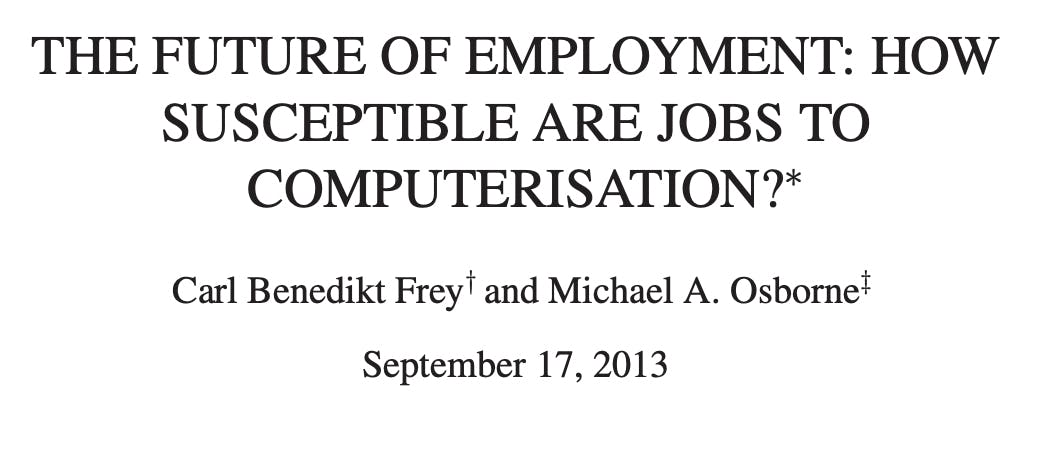The Transformation of the Labor Market by GPT-4-like Artificial Intelligence: Exploring the Future of Employment

In "The Future of Employment: How Susceptible are Jobs to Computerisation?", authors Carl Benedikt Frey and Michael A. Osborne explore the potential impact of technological advancements, specifically automation, on the labour market. They assess the susceptibility of various occupations to computerization by considering three factors: perception and manipulation tasks, creative intelligence, and social intelligence.

How come artificial intelligence finds it challenging to exhibit creativity?
Creativity involves complex cognitive and emotional skills that are difficult to program into an AI system. It requires context-specific understanding, risk-taking, and adaptation, which are challenging to formalize. Additionally, creativity is fueled by human emotions, motivations, and social interactions, which AI lacks. Therefore, while AI can enhance creative tasks, it is unlikely to replace human creativity anytime soon.
The authors employ a novel methodology that combines expert opinions and machine learning algorithms to evaluate the likelihood of 702 occupations being automated in the future. Their findings suggest that approximately 47% of total US employment is at risk of being replaced by machines.
The paper highlights that low-skilled, routine jobs, such as those in manufacturing, logistics, and office administration, are the most vulnerable to automation. Conversely, jobs that require high levels of creativity, problem-solving, and social interaction, such as those in the arts, sciences, and healthcare, are less likely to be automated.

Frey and Osborne's work underscores the importance of adapting the workforce to the rapidly changing technological landscape. They emphasize the need for policies that promote skill development and education, facilitate labour market transitions, and encourage the creation of new jobs that are less susceptible to automation.
Occupations Most Vulnerable to Automation:
According to Frey and Osborne, low-skilled and routine jobs are the most susceptible to automation. Examples of such occupations include:
Telemarketers
Insurance underwriters
Watch repairers
Cargo and freight agents
Mathematical technicians
Sewing machine operators
Title examiners, abstractors, and searchers
Library technicians
Data entry keyers
Photographic process workers and processing machine operators
These jobs typically involve repetitive tasks, limited creativity, and minimal social interaction, making them prime candidates for automation.
Occupations Less Likely to be Automated:
In contrast, jobs requiring high levels of creativity, problem-solving, and social interaction are less likely to be automated. Occupations in the arts, sciences, and healthcare are considered more resilient in the face of automation. Examples include:
Psychiatrists
Social workers
Registered nurses
Graphic designers
Scientists and researchers
Teachers and educators
Physicians and surgeons
Engineers and architects
Marketing and sales professionals
Human resources managers
Given the growing impact of automation on the labour market, it's crucial to develop strategies that foster workforce adaptation. Some key approaches include:
Emphasizing skill development and education: Encourage lifelong learning and reskilling to help workers transition to more resilient occupations.
Facilitating labour market transitions: Provide support for workers who need to change careers or industries due to automation, including job placement services, financial aid, and access to training programs.
Encouraging the creation of new jobs: Promote entrepreneurship, innovation, and job creation in sectors less susceptible to automation.
Prioritizing soft skills: Develop social, emotional, and creative abilities that are less likely to be replaced by machines.
Preparing the next generation: Equip young people with the necessary skills and knowledge to navigate the evolving labour market.

While "The Future of Employment: How Susceptible are Jobs to Computerisation?" by Carl Benedikt Frey and Michael A. Osborne is a notable and influential paper, it has been criticized on several fronts. Here are some of the main criticisms or flaws:
Overestimation of automation potential: Some critics argue that the paper may overestimate the susceptibility of certain occupations to automation. They contend that while some tasks within a job might be automated, the entire job may not necessarily be replaced by machines, as human input may still be required for more complex tasks or decision-making.
Limited focus on technological advancements: The paper primarily focuses on the potential impact of computerization and automation on the labour market. However, other technological advancements, such as augmented reality, biotechnology, and nanotechnology, could also influence the future of work, which are not explicitly considered in the study.
Inability to predict future job creation: The study's focus on existing occupations limits its ability to predict new jobs that might emerge as technology advances. New industries and occupations could be created in response to technological changes, offsetting some of the job losses resulting from automation.
Exclusion of labour market dynamics: The paper does not thoroughly address how labour market dynamics, such as supply and demand for different skills, wage levels, and regulatory policies, could affect the rate of automation. These factors could slow down or accelerate the adoption of automation in various industries.
Static nature of the data: The study's data is based on a snapshot of the labour market at the time of publication. As the labour market evolves and new jobs emerge, the susceptibility of various occupations to automation may change. The findings may not remain valid indefinitely, as the technological landscape and labour market conditions continue to evolve.
Uncertainty of timeframes: The paper does not provide a clear timeframe for when the predicted job losses due to automation might occur. Without specific timeframes, it is challenging to assess the urgency of the issue and develop appropriate policy responses.
Reliance on expert opinions: The methodology used in the paper combines expert opinions with machine learning algorithms. The potential for bias in expert opinions and the subjectivity of their assessments could affect the accuracy of the study's findings.
In conclusion, Frey and Osborne's paper on the susceptibility of jobs to automation offer valuable insights but has notable flaws. Critics argue that it may overestimate automation potential, focus too narrowly on existing jobs and specific technologies, and not account for labour market dynamics or timeframes. Despite these limitations, the paper serves as a crucial starting point for discussing the future of work and the need for proactive strategies to adapt to technological changes.
Also Yuval Noah Harari, in his book "Homo Deus: A Brief History of Tomorrow," refers to the paper "The Future of Employment: How Susceptible are Jobs to Computerisation?" by Carl Benedikt Frey and Michael A. Osborne. Harari discusses the impact of technology on society and the future of humanity, including the consequences of AI and automation on social, political, and economic systems. By mentioning Frey and Osborne's paper, Harari underscores the importance of understanding the potential effects of automation on the labour market and the need to adapt to a rapidly changing technological landscape.
Both Harari's work and the paper by Frey and Osborne contribute to the ongoing conversation about the future of work, emphasizing the need for proactive strategies to address the challenges posed by automation and other technological advancements. Harari's ideas also highlight the broader ethical and philosophical implications of these changes for human values, power dynamics, and the essence of human existence.
"You can't use up creativity. The more you use, the more you have."
- Maya Angelou
https://www.oxfordmartin.ox.ac.uk/downloads/academic/The_Future_of_Employment.pdf

